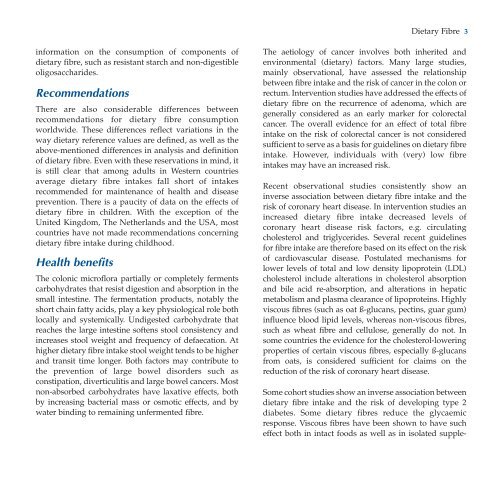Dietary Fibre - ILSI Argentina
Dietary Fibre - ILSI Argentina
Dietary Fibre - ILSI Argentina
Create successful ePaper yourself
Turn your PDF publications into a flip-book with our unique Google optimized e-Paper software.
<strong>Dietary</strong> <strong>Fibre</strong> 3<br />
information on the consumption of components of<br />
dietary fibre, such as resistant starch and non-digestible<br />
oligosaccharides.<br />
Recommendations<br />
There are also considerable differences between<br />
recommendations for dietary fibre consumption<br />
worldwide. These differences reflect variations in the<br />
way dietary reference values are defined, as well as the<br />
above-mentioned differences in analysis and definition<br />
of dietary fibre. Even with these reservations in mind, it<br />
is still clear that among adults in Western countries<br />
average dietary fibre intakes fall short of intakes<br />
recommended for maintenance of health and disease<br />
prevention. There is a paucity of data on the effects of<br />
dietary fibre in children. With the exception of the<br />
United Kingdom, The Netherlands and the USA, most<br />
countries have not made recommendations concerning<br />
dietary fibre intake during childhood.<br />
Health benefits<br />
The colonic microflora partially or completely ferments<br />
carbohydrates that resist digestion and absorption in the<br />
small intestine. The fermentation products, notably the<br />
short chain fatty acids, play a key physiological role both<br />
locally and systemically. Undigested carbohydrate that<br />
reaches the large intestine softens stool consistency and<br />
increases stool weight and frequency of defaecation. At<br />
higher dietary fibre intake stool weight tends to be higher<br />
and transit time longer. Both factors may contribute to<br />
the prevention of large bowel disorders such as<br />
constipation, diverticulitis and large bowel cancers. Most<br />
non-absorbed carbohydrates have laxative effects, both<br />
by increasing bacterial mass or osmotic effects, and by<br />
water binding to remaining unfermented fibre.<br />
The aetiology of cancer involves both inherited and<br />
environmental (dietary) factors. Many large studies,<br />
mainly observational, have assessed the relationship<br />
between fibre intake and the risk of cancer in the colon or<br />
rectum. Intervention studies have addressed the effects of<br />
dietary fibre on the recurrence of adenoma, which are<br />
generally considered as an early marker for colorectal<br />
cancer. The overall evidence for an effect of total fibre<br />
intake on the risk of colorectal cancer is not considered<br />
sufficient to serve as a basis for guidelines on dietary fibre<br />
intake. However, individuals with (very) low fibre<br />
intakes may have an increased risk.<br />
Recent observational studies consistently show an<br />
inverse association between dietary fibre intake and the<br />
risk of coronary heart disease. In intervention studies an<br />
increased dietary fibre intake decreased levels of<br />
coronary heart disease risk factors, e.g. circulating<br />
cholesterol and triglycerides. Several recent guidelines<br />
for fibre intake are therefore based on its effect on the risk<br />
of cardiovascular disease. Postulated mechanisms for<br />
lower levels of total and low density lipoprotein (LDL)<br />
cholesterol include alterations in cholesterol absorption<br />
and bile acid re-absorption, and alterations in hepatic<br />
metabolism and plasma clearance of lipoproteins. Highly<br />
viscous fibres (such as oat ß-glucans, pectins, guar gum)<br />
influence blood lipid levels, whereas non-viscous fibres,<br />
such as wheat fibre and cellulose, generally do not. In<br />
some countries the evidence for the cholesterol-lowering<br />
properties of certain viscous fibres, especially ß-glucans<br />
from oats, is considered sufficient for claims on the<br />
reduction of the risk of coronary heart disease.<br />
Some cohort studies show an inverse association between<br />
dietary fibre intake and the risk of developing type 2<br />
diabetes. Some dietary fibres reduce the glycaemic<br />
response. Viscous fibres have been shown to have such<br />
effect both in intact foods as well as in isolated supple-

















